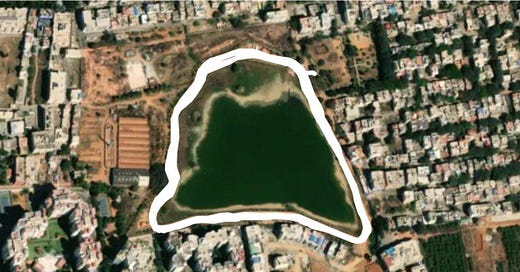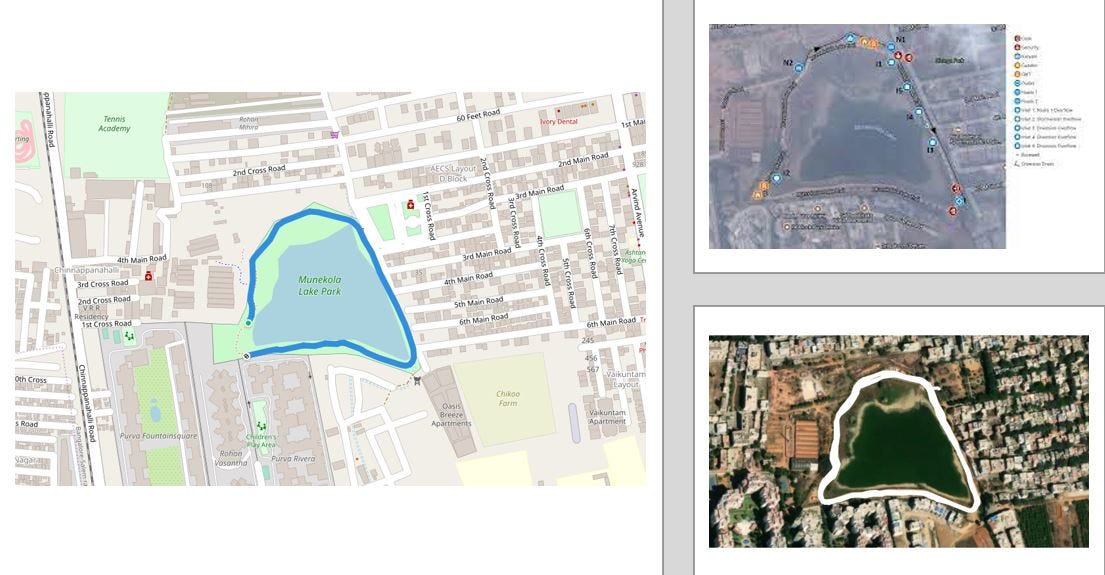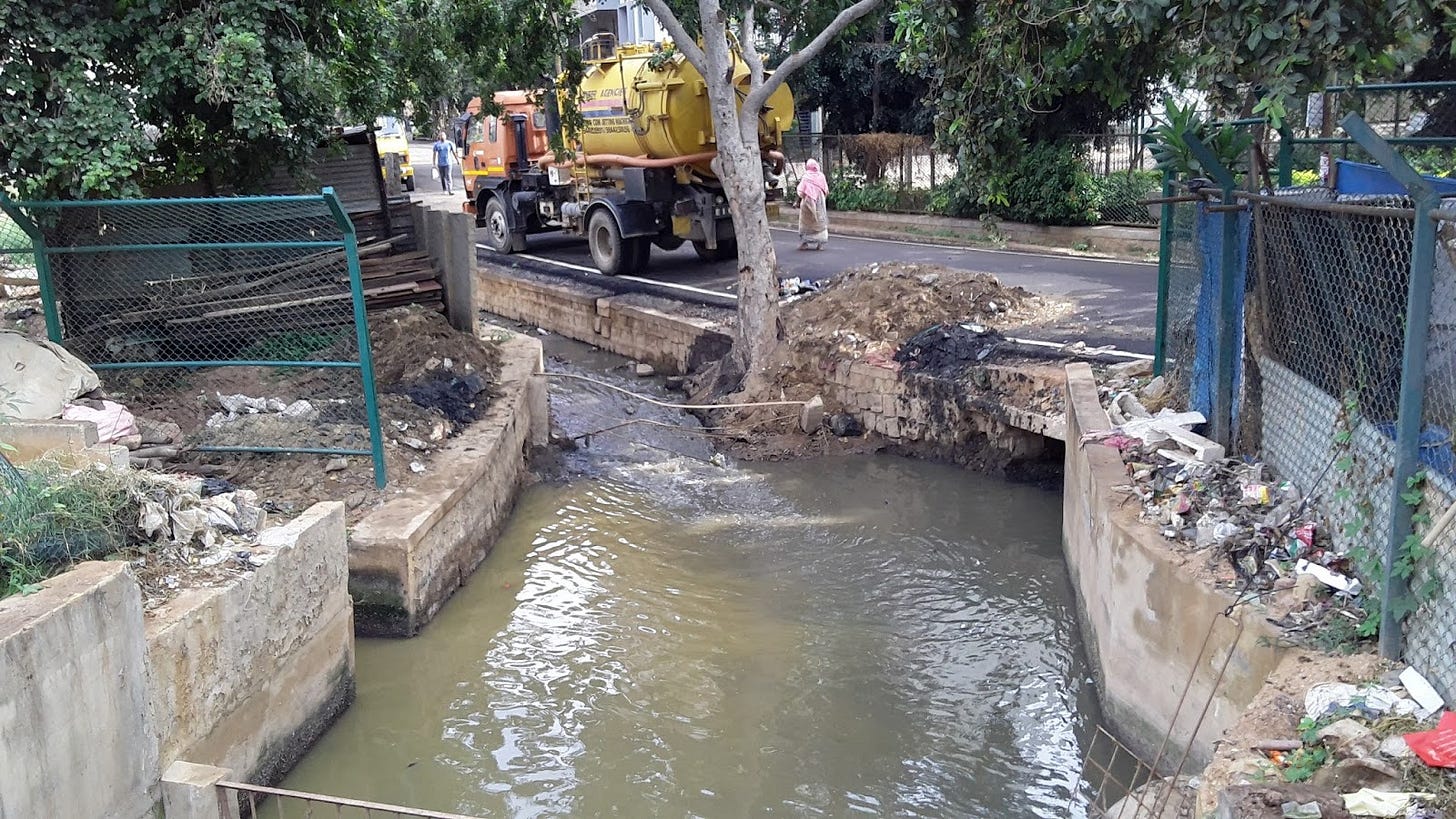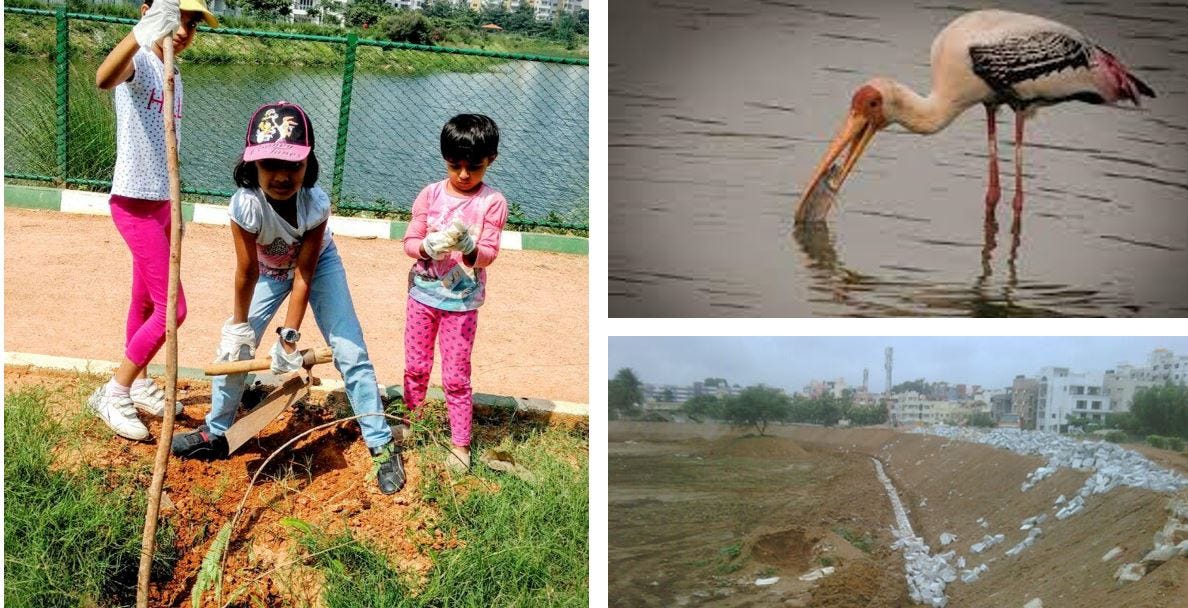Restoration of Munnekolala Lake – A Case Study
Bengaluru is a city of lakes. Starting with Kempa Gowda, the chieftain of the Vijayanagara kingdom who was in charge of the city has developed and nurtured water bodies for a safe supply for its inhabitants.
But over a period, this lost its prominence. Starting with harnessing the Akravathi river in 1896, and then Cauvery in 1974 water in Bengaluru became river sources. And lakes fell into oblivion.
The inevitable happened – lakes and lakebeds became ready sources of land for the expanding city. First for government projects, then for private commercial properties, and finally for residential units – the lakes were first on the real estate chopping blocks.
But nature has a way of pushing back, and water logging reached emergency levels in the city starting in early 2000. And main causes were identified – chocked/blocked Raj Kaluves (large drains) preventing water flows, and lake degradations/ encroachments affecting storage, and groundwater levels. And a whole lot of citizens became active in saving the lakes.
One of them was Munnekolala Lake, which took more than a decade to come to be one of the biggest success stories. Here is a snapshot spanning a decade to give a sense of the transformation.
The early days
The journey of the restoration started more than a decade back when one resident of Rohan Vasanta (a large apartment complex adjoining the lake) felt moved by the plight of the lake.
Situated behind the sprawling new apartment complexes of Purva Riviera, Rohan Vasanta, and Purva Fountainsquare Munnekolala Lake is one of the last of the lakes of the lake city of Bengaluru, which was minimally encroached. But the conditions were bad. Untreated waste water was flowing into it, exists was closed, water had largely dried up, potassium deposits had killed the aquation life, and the polluted water was covered with green.
The initial days were building awareness. A slide deck was created with photographs from various vantage points around the lake, and it was circulated to possible champions and volunteers.
This brought a core group together. One young man took the initiative of cleaning some of the vegetation every weekend on his own, and this too created a sense of purpose.
Visit the lakeside
While all the enthusiasts had a view of the lake from their balconies, nothing prepared them when a joint visit to the lake was organized. It was quite a struggle to even access it from the apartments’ side, as the path was blocked by vegetation, covered with human and animal excreta, and dumps of garbage.
Once there, there were some surprises. First was the temple of Van Devatha, the Jungle God.
The other one was the burial ground, which was discovered by a Hindu tribal community. They had been cremating their departed there for generations. However, they were very close to the new residential boundary walls.
These brought in two new boundaries:
Temple – which needs to stay, and the restoration has to be around it.
Burial ground – can be closed only if an alternative can be provided, as the sentiments of the people are involved.
Getting to know the official documents and the officials
This was crucial – what exactly is the lake and the lakebed, and how to access the official documents for this?
There may be many available maps, but the one that will be honored by the government will be the one approved by the land records department.
While many felt this would be a difficult step, surprisingly it turned out to be easy. After a couple of visits to the BBMP office, we came to know that Munnekolala lakes comes under the Forest Department. We met the concerned officer Mr. BV Satish (Chief Engineer, BBMP Lakes), and got the lake layout diagram. And yes, Mr. Satish was very enthusiastic about the entire initiative.
Reaching out to the influencers and stakeholders
After we aligned the Management Councils of the three apartment complexes abutting the lake, we set out to reach people working on lake preservation.
One of them was Dr. A N Yellappa Reddy, who serves as the Chairman of Bangalore Environment Trust. Dr. Reddy had been Secretary of the Department of Ecology and Environment and had been a long-term champion of lake restoration. Dr. Reddy visited the site, and site and promised full support.
We also reached out to the AECS layout members, as they were on the other side of the lake. And there came a new finding – where is the lake waste coming from?
AECS (Aeronautical Engineers Co-operative Society) is a sprawling layout set up off the Munnekolala Lake by the Bangalore Development Authority (BDA) in 1986. Originally built for retired aeronautical engineers, it had a sanctioned plan of 1,670 units. Two Sewage Treatment Plants (STPs) were built to cater to the sludge load.
As time passed, however, the original allotted started selling their properties. And what came up were multi-unit entities, many of them did not build their old STP. They just connected to the underground sewage pipes, and soon the two STPs were unable to handle the load. The sewage started to overflow into the Munnekolala lake.
Study of successful lake restoration projects
It is always good not to reinvent the wheel, and there have already been some success stories. A discussion with some of them shared the following basic steps:
1. Diversion of the sewage water coming into the lake. If it can’t be, consolidate all the inlets and set up a Sewage Treatment Plant (STP) just before it enters the lake.
2. Secure the lake area with fencing.
3. Excavation of the lake bed, and dumping the debris on the lake periphery.
4. Plant trees on the edges so that the debris is held firm and does not come back to the lake water in the next rain.
5. Clean the water using appropriate chemicals.
6. Create a walkway and other citizen facilities around the lake for collective ownership.
There are enough volunteer experts in Bengaluru to help with the plans, but funds are difficult to come by. So we explored one such effort for Sheelavanthakere Lake, which was championed by the residents of Adarsh Palm Medows.
The following were some of the learning in the discussions:
1. Back-of-the-envelope estimate for a lake of the size of Munnekolala (15+ acres) will need a couple of crores for initial restoration, and then budgets run into Lakhs for maintenance.
2. Funds can be mobilized through crowdsourcing, but in all probability, it will not be sufficient even for initial capital investment. Also, as the sustainability of the crowdsourcing model is a challenge, this will endanger long-term success.
3. Alternate fund sources are primarily CSR (from corporates located in the Whitefield area), MP Local Area Development (MPLAD) fund, and MLA Local Area Development (MLALAD) fund.
MPLAD and MLALAD will be one-time, and CSR will mostly not commit operational expenses (Opex) in the future years.
4. The best way forward was thus the adoption of the lake by BBMP (Bruhat Bengaluru Mahanagara Palike) for a long-term guarantee of success.
Getting Munnekolala Lake on the BBMP restoration list
This will happen when local political representatives (Councillor, MLA, MP) push BBMP. Pollical representatives will focus on an issue if a sizeable voter base asks for it.
Between Purva Riviera, Rohan Vasanta, and Purva Founatainsqauer there are around 2,600 dwelling units, and upwards of 5,000 voters. A formidable “vote bank” needs to be showcased.
During a meeting with the local MLA (Arvind Limbavali of Mahadevapura constituency), we invited him to do a meeting public interaction (Janata Darshan) in our apartment. It was accepted, we arranged, more than 100 apartment complex representatives were invited, and all the officials of all government departments joined (BBMP, BWSSB, KSPCB, BESCOM, DULT, etc.).
And there people wanted support for the lake restoration, and promises of support were made by the elected representatives, and relevant directions were given to the officials.
The survey, Budget Allocation, Work
Thus started the next and most critical phase, where the government machinery was activated.
A Detailed Project Report (DPR) was prepared by the Lake Development Authority and an initial budget of INR 2.7 crores was allocated (followed by another INR 1.15 crore in the next tranche).
The fund was used for:
1. Dredging the lake bed and creating embankments as walkways.
2. Diverting the sewage water into drains.
3. Fencing of the lake area.
4. Entertainment zone.
All these happened with active citizen participation at every stage. Volunteers organized themselves into Munnekolala Lake Restoration Association, and remained engaged, including gentle nudges whenever the pace slowed down.
Residents, along with the corporates did activities like tree plantation, which helped strengthen the boundaries. Birds came back, and some amount of pisciculture started. And most of all, hundreds of people started visiting the lake – every day.
So what are the learnings in this journey?
There are many, but I will highlight the top 10:
1. It takes a long time to get social issues resolved. There are many stakeholders, many moving parts, and many uncertainties. But if there is a long-term focus, things will happen.
2. People involved will change over time. New champions will emerge and take leadership. So long focus is on making progress, and not hankering for the glory it is movement in the right direction.
3. People’s involvement is necessary, even if few are involved on the ground. Efforts need to be taken to make people in nearby areas to be made aware of the challenges, and potential benefits.
4. Politicians are inevitable to make things work, and they get energized with potential votes. Hence the strength of the “vote bank” is to be demonstrated.
5. Crowdfunding may give a kickstart, but it is not a long-term solution for large, long-term projects. The same is the case with CSR, MLALAD, and MPLAD funds. The best way is to make it a project of the government for long-term sustainability.
6. There are enough experts available for all civic initiatives, and they are willing to offer their services pro bono. However one needs to identify the real experts and then seek them.
7. There are enough vested interests to scuttle any initiatives, especially where a lucrative resource like the land is involved. However, if the civic society, experts, elected representatives, and officials are aligned the job gets easier.
8. Involvement of people continuously through volunteerism (tree plantation, logging, etc.), corporate engagements, or as members of the steering committee, etc. is vital for long-term success. The situation can retrace very fast – eternal vigilance is necessary.
9. Media coverage is great to give recognition to the volunteers, politicians, and bureaucrats, and make stakeholders aware of the progress.
10. And last – things change only when we try. And we may always be there physically to see the final output (or even the intermediate ones). But it is always worth the effort.











